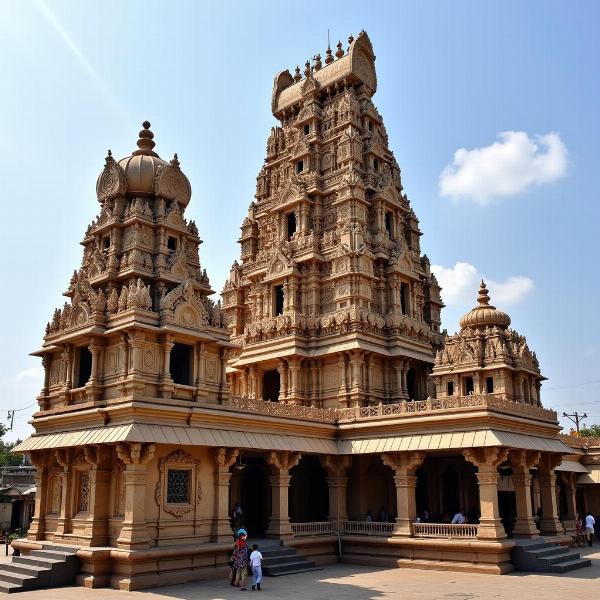Kamakshi, a name that resonates with power and mystique, holds deep significance in Hindu mythology. Understanding the kamakshi meaning in hindi unlocks a world of symbolism and devotion surrounding this powerful goddess. This article delves into the various interpretations and cultural significance of Kamakshi, exploring her attributes, iconography, and the stories that have shaped her worship.
Deciphering the Name: Kamakshi Meaning and Interpretations
The name Kamakshi is a composite of three Sanskrit words: ka, ma, and akshi. Ka refers to the goddess Saraswati, representing knowledge and wisdom. Ma signifies Lakshmi, the goddess of wealth and prosperity. Akshi translates to “eye,” symbolizing the watchful and benevolent gaze of the goddess. Thus, Kamakshi embodies the combined power of Saraswati and Lakshmi, her eyes representing their divine oversight. Another interpretation suggests that kama refers to desire, specifically the desire for liberation or spiritual fulfillment, and akshi represents the eye that grants this desire. This meaning highlights Kamakshi as the fulfiller of righteous desires and the guide towards spiritual enlightenment. A third interpretation links kama to love, suggesting that Kamakshi represents the loving and compassionate aspect of the divine mother.
Kamakshi in Hindu Scriptures and Mythology
Numerous legends and stories surround Kamakshi, enriching her significance in Hindu mythology. One prominent narrative recounts how Kamakshi performed intense penance under a mango tree to win the heart of Lord Shiva. Her unwavering devotion ultimately led to their union, solidifying her status as a powerful and determined goddess. Another story portrays Kamakshi as the embodiment of Parvati, Shiva’s consort, who emerged from the flames of Sati’s self-immolation. This association connects Kamakshi with the themes of rebirth, transformation, and the enduring power of divine love.
Kamakshi Iconography and Symbolism
Kamakshi’s iconography is rich with symbolism. She is typically depicted with four arms, holding a sugarcane bow, parrot, noose, and goad. The sugarcane bow represents the sweetness of love and devotion, the parrot symbolizes speech and knowledge, the noose signifies control over the mind, and the goad represents the power to guide devotees towards the righteous path. She is often seated on a five-petaled lotus, symbolizing purity and spiritual awakening.
 Intricate architecture of Kamakshi Amman Temple
Intricate architecture of Kamakshi Amman Temple
Kamakshi’s Significance in Kanchipuram
Kanchipuram, a city renowned for its temples and silk sarees, is considered the primary abode of Kamakshi. The Kamakshi Amman Temple in Kanchipuram is one of the 51 Shakti Peethas, sacred sites where parts of Sati’s body are believed to have fallen. This temple attracts devotees from all over India, who seek Kamakshi’s blessings for love, prosperity, and spiritual growth.
How is Kamakshi Worshipped?
Devotees express their reverence for Kamakshi through various rituals and practices, including chanting her mantras, offering flowers and fruits, and performing special pujas during festivals like Navaratri. The Sri Chakra, a complex geometric diagram, plays a central role in Kamakshi worship, representing the universe and the goddess’s cosmic energy.
Conclusion: Embracing the Power of Kamakshi
Understanding the kamakshi meaning in hindi offers a deeper appreciation for this powerful and multifaceted goddess. From her association with knowledge, wealth, and love to her role as a guide towards spiritual fulfillment, Kamakshi embodies the nurturing and transformative aspects of the divine feminine. Her worship continues to inspire and uplift countless devotees, reminding them of the inherent power within themselves to achieve their desires and attain spiritual enlightenment.
FAQ:
- What is the main significance of Kamakshi? Kamakshi embodies the combined power of Saraswati and Lakshmi, representing knowledge, wealth, and spiritual fulfillment.
- Where is the main temple of Kamakshi located? The primary abode of Kamakshi is the Kamakshi Amman Temple in Kanchipuram, Tamil Nadu.
- What does the Sri Chakra represent in Kamakshi worship? The Sri Chakra represents the universe and the goddess’s cosmic energy.
- What are some common offerings made to Kamakshi? Devotees offer flowers, fruits, and perform special pujas.
- What is the significance of Kamakshi’s four arms? Each item held in her hands symbolizes different aspects of her power and blessings, from love and knowledge to control over the mind and spiritual guidance.
- What does the name Kamakshi literally mean? Kamakshi can be interpreted as “one with eyes of love and desire,” or “one whose eyes grant desires.”
- Is Kamakshi associated with any specific festivals? Navaratri is a prominent festival associated with Kamakshi worship.
Meaning-Hindi.in offers professional and accurate translation services between Hindi and various other languages. Our expertise spans across diverse domains, including business and commercial documents, legal and certified translations, technical manuals, website localization, and academic materials. We provide fast and reliable services tailored to your specific needs. Whether you need to translate your business contracts or academic transcripts, Meaning-Hindi.in is your trusted language partner. Contact us at [email protected] or +91 11-4502-7584 to discuss your translation requirements. Connect with Meaning-Hindi.in today!